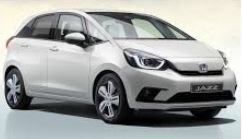chimeric oncogene
ACCESS: Secret
- Joined
- 23 May 2019
- Messages
- 347
- Reaction score
- 429
A bit long for a toilet break, IMO, but one hopes they will get the charging speeds up.charging at a couple of stops for 15 minutes
A bit long for a toilet break, IMO, but one hopes they will get the charging speeds up.charging at a couple of stops for 15 minutes
Why? Cars drive themselves in the future. Sleep through the trip.After 4 hours of driving, 15 min is a ridiculously short break. Recommended is 15 min every 2 hours, 30-60 min after 4 hours.
Be honest with yourself, you like big boofy trucks and SUVs because you like them, no other reason,
"... bodies to dispose of..."? Ewwwwwwww.
Well, you don't want to just leave 'em on your porch, do ya?
"... bodies to dispose of..."? Ewwwwwwww.
Well, you don't want to just leave 'em on your porch, do ya?
All electronic communications are monitored.
They'd have automated recharging/fueling sorted out long before robotaxi rollout.
I do wonder if inductive chargers buried in roads makes sense.
None of the above points is really necessary for the technology to make sense. A vehicle with lower costs than traditional ICE (1/2 or less engine output, steady state operation, plus small battery) with operating costs of a BEV (95% of trips is short range), with no sacrifice in performance (outside of continuous peak output, aka racing) is possible.According to 2012 Amendments to the Zero Emission Vehicle Regulations adopted in March 2012 by the California Air Resources Board (CARB), a range-extended battery-electric vehicle, designated as BEVx, should comply, among others, with the following criteria:[2]
- The vehicle must have a rated all-electric range of at least 120 km (75 miles). This is higher than the 80 km (50 miles) required of a zero-emission vehicle;
- The auxiliary power unit (APU) must provide range less than or equal to battery range;
- The APU must not be capable of switching on until the battery charge has been depleted;
- The vehicle must meet super ultra low emission vehicle (SULEV) requirements; and
- The APU and all associated fuel systems must comply with zero evaporative emissions requirements.
Nailed it.Sometimes I wonder if America is at the grips of the counter-force, in which every possible improvement in transport technology is countered by equal and opposite development in zoning, regulations and urban planning, with things like cul de sac and Stroads nicely neutralizing the automobile.
cant we just beam the energy down to the cars as microwaves?They'd have automated recharging/fueling sorted out long before robotaxi rollout.
GONK
I do wonder if inductive chargers buried in roads makes sense.
Great, now I'm having Solar Freakin' Roadways flashbacks.
cant we just beam the energy down to the cars as microwaves?
"... bodies to dispose of..."? Ewwwwwwww.
Well, you don't want to just leave 'em on your porch, do ya?
All electronic communications are monitored.
No! Really? You shock me, sir. Next you'll tell me that some people lack a sense of humor, satire or sarcasm.

 www.aptera.us
www.aptera.us
One major difference is that oil is irreversibly turned into carbon dioxide and water vapor but lithium is one electrode of a rechargeable battery, so it's not completely destroyed. There are, of course, also alternative battery technologies that are being developed, some of which may be in use in a few years, some of which don't use lithium.Sure replacing oil (a finite resource) by lithium (another finite resource) won't help.
It is also a matter of 8 billion people (soon) wanting a common standard of living: the one from the advanced countries which is all by itself unaffordable...

One major difference is that oil is irreversibly turned into carbon dioxide and water vapor ...
One major difference is that oil is irreversibly turned into carbon dioxide and water vapor ...
Hardly irreversible. Go to YouTube, search for "plastic waste into diesel" or words to that effect. You'll find videos from high tech European companies building advanced transportable containerized systems that you pour scrap plastic into and get fuel out of; you'll find videos from third world villagers and back woods survivalists turning plastic into fuel using hardware that itself was scrap. With a bit more effort you can turn *any* hydrocarbon into petroleum; a company 15 or so years ago was turning dead turkeys into oil.
Plants, sewage, dead animals, plastic and paper waste are a virtually infinitely renewable resource that, unlike lithium, you don't need to go mining for. Hell, people will willingly *dump* this resource on you.
Absolutely irreversible; CO2 + H2O => CnHm (where n and m are integers) is both energetically (First Law) and entropically (Second Law) disadvantageous.

O RLY ?

Willis Eschenbach radiates more nonsense at WUWT
Willis Eschenbach at WUWT decided there are three what he calls "theories" to the greenhouse effect, demonstrating that he doesn't understand that radiation is the emission or transmission of energy. He was trying to attack a tweet thread by Gavin Schmidt and his attack was laughable (and very...blog.hotwhopper.com
Climate change denial. Hell, no, we don't go.
No surprise that guy isn't exactly enthusiastic about EVs...
You nailed it, Arjen. "Credibility" is really the point I wanted to make








- There's absolutely no need to flood the reports for every single post in a thread, that doesn't reflect the reporters
opinion !
Replacing billions of individual engines with 3+ orders of magnitude less engines at combined less than 30% rated output is a problem?Is his math wrong about the need to install a *lot* of electrical power fairly quickly? "Climate change" and "electric cars" are separate topics.
Despite the best effort of thermodynamics, the oxygen catastrophe does not appear to reverse itself.One major difference is that oil is irreversibly turned into carbon dioxide and water vapor

Then there is actually spending more than 3 brain cells on the whole whole federal tax credits thing: A tax rebate that is basically a giveme to wealthy urbanites and not optimized for cost/emissions or even industrial strategy. (granted, it is the main voter block of one of the parties, but that does not make it less ugly)In 2006, CAFE altered the formula for its 2011 fuel economy targets, by calculating a vehicle’s “footprint”, which is the vehicle’s wheelbase multiplied by its wheel track... Fuel economy targets are a function of a vehicle’s footprint.... rather than encouraging auto makers to strive for unprecedented fuel economy in their passenger car offerings, it has incentivized auto makers to build larger cars, in particular, more car-based crossovers that can be classified as “trucks” as used to skew fleet average figures, much the same way the PT Cruiser did. Full-size trucks have become a “protected class”, safe from the most aggressive targets, while compact trucks have become nearly extinct as a result.
All of these sites have batteries, so the grid is not overburdened, and they probably have contracts to allow the National Grid to limit their take, literally second to second, to help balance the Grid.The National Grid in the UK don't seem too concerned.
By 20230 they hope to have 40GW of offshore wind power, which is 30GW more generating capacity than we currently have.
They estimate that even if everyone in the UK swapped to an EV overnight, the peak demand would only increase by 10%. The big problem is handling when the spikes occur.
The highest demand in the UK peaked in 2002 at 62GW but has now fallen to just over 50GW in winter. So that extra 30GW in capacity should more than cover it and that's not including new nuclear or other renewable sources factored in.
The largest EV charging site in the UK currently under construction has 38 fast and ultra-rapid chargers with a combined capacity of 10MW straight from the National Grid. 40 of these sites are planned. So that's around 0.4GW combined to charge 1,520 cars on rapid charge.
You have to remember that for most people they will be charging off-peak overnight (thus you can spread the load 24 hours a day) and with short journeys you will recharge less often just as you fill up less often. For people doing long-distance miles its a different matter, rapid charging is certainly a power hog.
Also, simple miles = GW maths doesn't factor in hybrids with self-charging and energy recouping from regenerative braking etc.
https://www.autocar.co.uk/car-news/...ysis-how-uk-grid-will-cope-ev-revolution-2030
https://www.autocar.co.uk/car-news/advice-electric-cars/how-national-grid-will-work-electric-cars
https://www.thisismoney.co.uk/money...bly-robust-cope-electric-car-demand-2030.html
CLIMATE DENIAL is not tolerable on this site. I proved the source was from a climate denialist - like it or not, feel free to bury your head in the sand, I won't.
Replacing billions of individual engines with 3+ orders of magnitude less engines at combined less than 30% rated output is a problem?Is his math wrong about the need to install a *lot* of electrical power fairly quickly? "Climate change" and "electric cars" are separate topics.
Picking one argument, whatever it is, not necessarily means, that the poster supports all arguments from that source.- There's absolutely no need to flood the reports for every single post in a thread, that doesn't reflect the reporters
opinion !
CLIMATE DENIAL is not tolerable on this site. I proved the source was from a climate denialist - like it or not, feel free to bury your head in the sand, I won't.
God damn it, I was asked to do math - no problem with that (yeeeah! )
- but not to justify a flawed source, flawed = written by a climate denialist to justify his rotten agenda.
Common, we know that the source cited is touting impossible numbers just to justify his climate denial bullshit. That's the way it works, just read MERCHANTS OF DOUBT.
I can't accept this.
To get it fully sustainable you need Direct Carbon Capture from the air (Bio based fuels are massively inefficient;- 0.5% of input energy yielded as output ) . To remove 2019 CAT CO2 emissions using the best method available today (ie Carbon Engineering) it needs a capture machine which is 10m tall, ….5000km…..long and consumes an equivalent of…..one third of the electricity production of the USA today.
